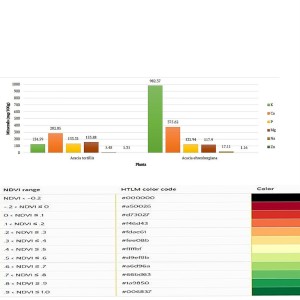
Unveiling the Nutritional Goldmine: Acacia Species as Native Fodder for Arabian Tahr in Fujairah, UAE
The United Arab Emirates, known for its harsh environmental conditions, harbors a unique array of flora and fauna. Among these, Acacia tortilis and Acacia ehrenbergiana are native plants that have adapted to thrive in the challenging climates of Fujairah. These plants have gained attention for their potential as fodder for the Arabian tahr, a native species whose dietary needs are critical for its survival and health. This study explores the nutritional values of these Acacia species and their distribution in Fujairah, providing a comprehensive analysis using modern techniques and satellite imagery.The Arabian tahr, native to eastern Arabia, is a species that depends heavily on the vegetation available in its habitat. These animals are primarily browsers, feeding on grasses, shrubs, leaves, and tree fruits. They serve as indicators of the health of their ecosystem, as their presence and condition reflect the state of their environment. Given their limited geographic range and specific nutritional requirements, it is essential to identify and promote native plants that can sustain their populations. Acacia tortilis and Acacia ehrenbergiana are prime candidates due to their resilience and nutritional benefits.To assess the nutritional potential of these plants, a series of standard analytical methods were employed. The dry matter content, crude protein, crude fat, total sugar, and total digestible nutrients (TDN) were measured, alongside the concentration of essential minerals such as potassium, calcium, magnesium, and phosphorus. The analysis revealed that Acacia ehrenbergiana generally offers higher nutritional benefits compared to Acacia tortilis. Specifically, Acacia ehrenbergiana provides significantly higher levels of potassium and calcium, which are vital for muscle development and bone strength, respectively. This makes it a superior dietary option for the Arabian tahr, contributing to their overall health and sustainability.The study made by team researchers at Fujairah Research Centre (FRC) also involved mapping the vegetation of Fujairah during the blooming period of these Acacia species using satellite imagery from Sentinel-2. The Normalized Difference Vegetation Index (NDVI) was employed to mark areas of vegetation. NDVI is a widely used indicator that measures the density and health of plant growth by comparing the absorption of chlorophyll in the red wavelength to the scattering of near-infrared light by green leaves. Values above 0.2 were marked as vegetated areas, allowing for a detailed visualization of the distribution of these plants.The results showed a notable variation in vegetation cover over the months of March to May 2022. In March, approximately 266.4 km2 of Fujairah was covered by vegetation, primarily attributed to agricultural lands. This area decreased to 252.9 km2 in April and further shrunk to 99.8 km2 in May. These shifts highlight the seasonal dynamics of plant growth in the region, influenced by factors such as rainfall and temperature. The mapping not only provides a snapshot of the current state of vegetation but also serves as a blueprint for future planning and conservation efforts.
The study underscores the importance of Acacia tortilis and Acacia ehrenbergiana as native fodder plants for the Arabian tahr. While both plants offer substantial nutritional benefits, Acacia ehrenbergiana stands out with its higher mineral content, making it a more beneficial diet for these animals. The absence of heavy metals in both plants further confirms their safety for consumption. Additionally, the vegetation mapping offers valuable insights into the distribution and density of these plants, facilitating better management and expansion strategies.In conclusion, the investigation into the nutritional potential and vegetation blueprint mapping of Acacia tortilis and Acacia ehrenbergiana highlights their significance as native fodder plants for the Arabian tahr in Fujairah, UAE. By providing essential minerals and thriving in harsh environmental conditions, these plants contribute to the sustainability of the Arabian tahr population. The study’s findings pave the way for further research into optimizing the use of native vegetation to support local wildlife and enhance biodiversity conservation efforts. The integration of nutritional analysis and satellite-based vegetation mapping offers a comprehensive approach to understanding and managing the natural resources of Fujairah, ensuring a balanced ecosystem where both flora and fauna can flourish. For more detailed information read the full article by Al Dhanhani, A. S. S. J., Mirza, S. B., Alhefeiti, F. R. M. O., & Ridouane, F. L. (2023). Investigating the nutritional potential and vegetation blueprint mapping of Acacia tortilis and Acacia ehrenbergiana from the origin of Fujairah, UAE, for Arabian Tahr as native fodder plants. Advancements in Life Sciences, 10(1), 99-103.
